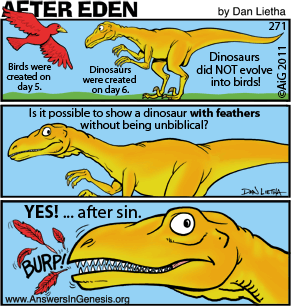I hope everyone had a terrific Harvest Day! As you might recall, last year I took part in the Nanowrimo (National Novel Writing Month) challenge, which requires me to write a 50,000-word novel during the month of November. I am doing this challenge again this year, so I will be posting quite a few rerun articles this month. Don't worry though, I'll pick articles from a little ways back.
Anyway, Thanksgiving will soon be upon us? Do you have any Thanksgiving traditions? If so, leave them in a comment below.
Days till:
It is: 16 days till
The Good Dinosaur's theatrical release
It is: 17 days till Thanksgiving
It is: 45 days till Christmas
In the Spotlight:
Again, nothing of note to share this week.
Topic of the Week by
Christian Ryan
 |
| Did dinosaurs really evolve into birds? What does the fossil record actually reveal? |
Every Thanksgiving, people all over the United States
cook and serve the American turkey. Despite not being part of the
first Thanksgiving, the turkey is a symbol for this holiday. But for
many Americans, they aren't merely eating a bird – they're actually
eating a dinosaur! Evolutionists believe that all birds, including the
turkey, descended from small, feathered theropod dinosaurs; to be more
accurate, they actually believe that birds are dinosaurs. Such a claim,
if true, would be a major problem for creationists. How should a
creationist respond to such this idea? What's the truth behind this
belief?
 |
| Is this delicious Thanksgiving entree the descendant of dinosaurs? |
The idea that reptiles evolved into birds isn't new.
Not long after renowned naturalist Charles Darwin published his book in
1859 called On the Origin of Species by Means of Natural Selection, or
the Preservation of Favored Races in the Struggle for Life . . . it's
easy to see why most people just call it The Origin of Species. In
1860, a feather was discovered fossilized in Germany and the species of
which the feather belonged to was called
Archaeopteryx. In 1863,
Sir Richard Owen (the inventor of the name “dinosaur” and a creationist)
described an entire skeleton of the creature; the fossils revealed a
relatively small creature, with feathered and clawed wings, teeth and a
long bony tail. In 1869, biologist Thomas Henry Huxley, often considered
“Darwin's Bulldog” declared the animal as the missing link between
reptiles – specifically dinosaurs – and birds. Ever since, most
evolutionary scientists cling to the idea that theropod dinosaurs
evolved into birds.
 |
| The similarities between dinosaurs like Compsognathus and birds led Huxley to believe that dinosaurs evolved into birds. |
Before we go any farther, we must understand both
perspectives of the origin of birds: the creation perspective and the
evolutionary perspective. Let's look at them both now. Most
evolutionists believe that sometime between the early to late Jurassic
Period, about 201-145 million years ago, the scales of small theropod
dinosaurs began evolving into fur-like proto-feathers for warmth. After
millions of years of evolution, these proto-feathers evolved to be
firmer and longer; dinosaurs began using their longer feathers for
display purposes, perhaps to attract mates. Evolutionists are unsure as
to how the power of flight came about. Some evolutionists believe these
feathered dinosaurs were tree-climbers and began using their feathered
limbs to glide through the trees; others believe they developed the
power of flight from the ground up, using their proto-wings to increase
their leaps into the air, perhaps after prey. Either way, these
dinosaurs eventually were able to get airborne and were now technically
birds.
 |
| An early conception of "proto-birds" from 1916. |
What does the Bible say about the evolution of birds?
Well, it says God created all the flying creatures on the Fifth day of
the Creation week, 6,000 years ago, the day before He created dinosaurs.
“And
God created...every winged fowl after his kind: and God saw that it was
good...And the evening and the morning were the fifth day.” Genesis
1:21-23.
This is a major contradiction to the
evolution story, which states that dinosaurs came about before birds.
Meanwhile the Bible states that land animals – dinosaurs included – came
after birds! And instead of evolving through the processes of natural
selection and mutation like evolution teaches, birds appeared on earth
fully-formed and ready for action.
.jpg/640px-Archaeopteryx_lithographica_(Berlin_specimen).jpg) |
| Evolutionists commonly point to Archaeopteryx as being a transitional form between dinosaurs and birds. |
Many evolutionists (specifically atheists) believe
that there is too much evidence for evolution for creation to be true. I
find it rather interesting how many evolutionists refuse to even
consider creation an option; in fact, many will go as far as to say that
creationists don't know science. I was browsing the internet and came
across an article entitled
Feathered Dinosaurs Drive Creationists Crazy
by Brian Switek. “Oh, really?” I thought upon seeing this article; I
was rather unimpressed by this evolutionist's attempt to denounce
creationists. Curious, I read the article, expecting to find much
criticism aimed at creationists. Much of the article was devoted to how
our view of dinosaurs has changed over the years, but perhaps a quarter
into the material, he talked about creationists and the “overwhelming
evidence” that dinosaurs evolved into birds, in addition to his other
criticisms about dinosaurs living with humans and dinosaurs living 6,000
years ago etc. He also spent a great deal of time talking about Answers
in Genesis CEO Ken Ham and the Creation Museum. Here's an excerpt
below:
“...dinosaurs with feathers are
not welcome at Ham's amusement park [speaking of the Creation Museum].
Even though paleontologists have uncovered numerous dinosaurs with
everything from bristles and fuzz to full-flight feathers—which document
the evolution of plumage from fluff to aerodynamic structures that
allowed dinosaurs to take to the air—creationists deny the clear fossil
record.”
He had much more to say of course, some of
which I'll get to in a minute. I must say that while reading the
article, I was troubled how many misconceptions Switek has about
creationism. What really ticks me off is when evolutionists try to make a
case for themselves without actually doing the research. I find
Switek's ignorance of what we creationists believe appalling. If only he
continued to research and find answers to
why creationists don't
believe dinosaurs evolved into birds, then perhaps he would not have
been so bold in his statements. Like any other fossils in the fossil
record, even though the observable evidence – dinosaur and bird fossils –
can point to or suggest a certain conclusion, they do not speak for
themselves and are left to the interpretation of the individual based
upon observable evidence. Evolutionists like to claim that creationists
start from a presupposition and use that to base their opinions on,
while they base their opinions on scientific facts. Now, it is true that
we have presumptions, but so do evolutionists! They fail to realize is
that they do the exact same thing. In this article, I plan to talk about
the evidence for and against the dino-to-bird hypothesis and see what
the evidence
best suggests.
So what
is the “evidence” for this belief in dinosaurs evolving into birds?
Switek claims there is a “mountain of evidence that birds are living
dinosaurs” and that we creationists deny the clear fossil record. Let's
at the so-called evidence now and see whether we're the ones rejecting
the clear fossil record. Before we go on though, let me explain that
evolutionists do not believe all dinosaurs evolved into birds; they
believe the ancestors of birds are maniraptorans, small theropod
(meat-eating) dinosaurs. Some of these dinosaurs include
Deinonychus,
Troodon and the famous
Velociraptor.
 |
| Dromaeosaurs, such as this Velociraptor, are commonly seen as relatives of modern birds. |
Bird-hipped and Lizard-hipped Dinosaurs
Evolutionists
are quick to mention that maniraptorans are very similar to modern
birds anatomically. This is true. In fact there are over 100 skeletal
features that dinosaurs share with birds; some dinosaurs such as
Velociraptor even had a wishbone. But what is often not mentioned are the often quite significant
differences between the two. Within the order
Dinosauria there
are two subcategories in which dinosaurs are divided, saurischians
(lizard-hipped dinosaurs) and ornithiscians (bird-hipped dinosaurs). The
dinosaurs in these two categories are divided based upon their hip
shape. The difference between the two hip shapes is the pubis bone; the
pubis bone in birds and bird-hipped dinosaurs points toward the rear
instead of to the front as in lizard-hipped dinosaurs, modern reptiles
and mammals.
 |
| Saurischian or lizard-like hip structure. |
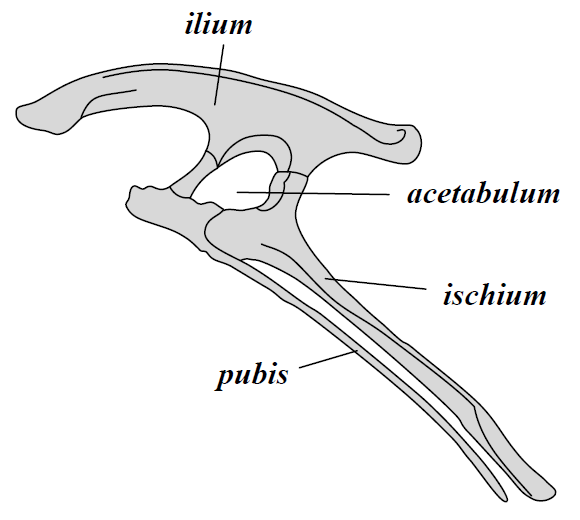 |
| Ornithischian or bird-like hip structure. |
Problem with dino-to-bird evolution? All the dinosaurs that evolutionists believe are related to birds (e.g.
Velociraptor,
Troodon,
Sinornithosaurus) are lizard-hipped! Dinosaurs that are bird-hipped include
Stegosaurus,
Triceratops and
Parasaurolophus.
These dinosaurs bear very few bird-like features and are not believed
to have evolved into birds. Yet the few times this is ever mentioned in
secular literature, documentaries and etc. this problem is never
presented any emphasis. And why would they?
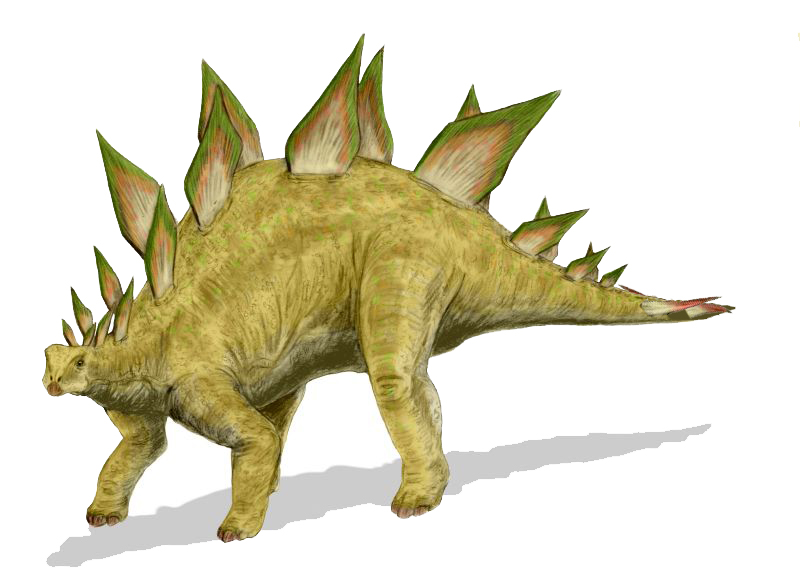 |
| The lumbering 4-ton Stegosaurus is a bird-hipped dinosaur, meaning it must have evolved into birds! Right? Of course not! |
Three-Fingered Hands
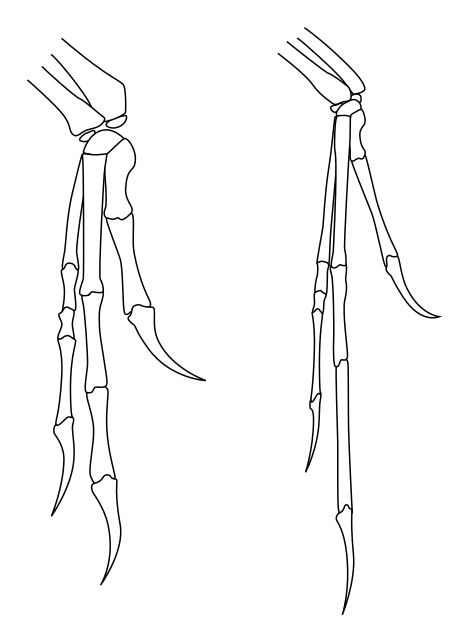 |
| The hand bones of Dienonychus (left) and Archaeopteryx (right) are quite similar. |
Evolutionists absolutely love to talk about how both
theropods and birds have three-fingered hand bones. Evidence of a
dino-bird relationship? Hardly. As birds supposedly evolved from
theropods, you'd expect that the digits represented in the hand bones
would be the same in both dinosaurs and birds. However, dinosaurs have
the 1st, 2nd, and 3rd digits (the first being the thumb); birds have the
2nd, 3rd, and 4th digits in their hand. What happened?
Avian vs. Reptilian Lungs
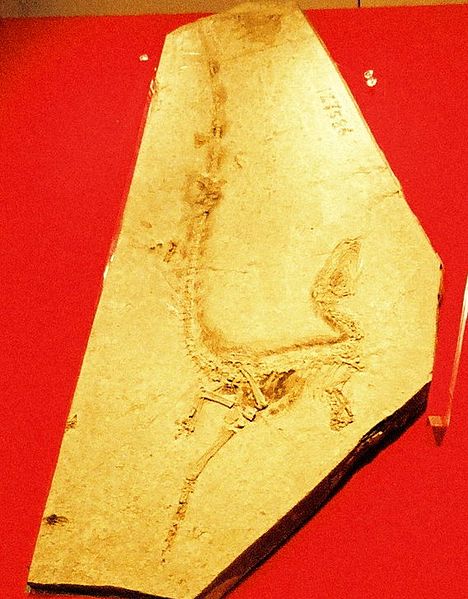 |
| The dinosaur Sinosauropteryx was so well preserved, that the reptilian-like lungs have also been fossilized. |
If theropods are the ancestors of birds, you should
find avian-like lungs in theropods. Of course, as most dinosaur remains
are fossil bones, we can't know too much about their lungs and
respiratory system. However, paleontologists have discovered the
fossilized remains of a
Sinosauropteryx, a small bird-like theropod from China, related to
Compsognathus.
This Sinosauropteryx specimen retains the outline of the visceral
cavity, and it is very well preserved. Much to the dismay of
evolutionists, they reveal that the lung is very much like that of a
crocodile.
In Switek's article, he mentions how the
Creation Museum didn't display feathered dinosaurs, nor does Answers in
Genesis portray dinosaurs with feathers in books and DVD's. And he's
right. But what if there's actually a scientifically good reason for
this? Of course, failing to do his research to see
why
creationists don't portray feathered dinosaurs, he just scoffs and
claims that “they take pride in promoting out-of-date, monstrous
dinosaurs that more easily fit their contention that these animals were
created separately from all other forms of life.” I'm very sorry Switek,
but maybe
you are the one who's trying to go against the fossil
evidence. Like just about every other evolutionist out there, he claims
that creationists just believe in non-feathered dinosaurs because we
believe they didn't evolve into birds and then points to so-called
“feathered” dinosaurs; no further explanation is given. He would have
only had to read a few articles on the
Answers in Genesis website to find their true opinion, which I will get to in a minute.
 |
| Is there actually evidence to support the belief that dinosaurs, like this Troodon, had feathers? |
There are two types of “feathered dinosaurs” you'll
hear about: dinosaurs with bird-like flight feathers and dinosaurs with
proto-feathers. First let's look at the dinosaurs with “proto-feathers”.
In 1996, evolutionists thought they found the amazing proof for their
theory upon the discovery of
Sinosauropteryx. This small
carnivorous dinosaur is associated with the outline of what many believe
to be fur-like proto-feathers. But upon looking at the “proto-feathers”
closely, you can see that they really aren't that feather-like. They
are much more similar to hair in appearence. In fact, it seems to some
creationists that seems that these features are actually connective
tissue fibers (collagen); this is found in the deeper dermal layers of
the skin. These features have been found not only on other dinosaurs,
but also ichthyosaurs,
dolphin-like marine reptiles! Yet
no one suggests these creatures were feathered. Another thing about the
"fluffy-looking" structures that creation scientists have noticed is
that many of these structures appear almost fur-like. Perhaps some of
these dinosaurs were covered in something similar to pcynofibers,
fur-like structures found on pterosaurs that are very similar to
mammalian hair.
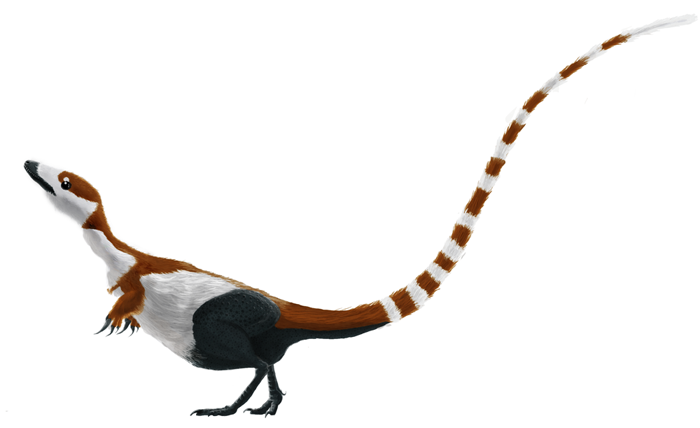 |
| Dinosaurs like Sinosauropteryx might have been covered in a type of "fur". |
In this article, Switek mentions this fossil discovery:
“Put feathers on a Velociraptor—we
know it had feathers thanks to quill knobs preserved along its arm
bones—and you get something disturbingly birdlike, revealing the
dinosaur's kinship to the ancestors of Archaeopteryx and other early birds.”
In 2007, scientists published the find of a fossil arm bone of a
Velociraptor.
Along the forearm are six bumps that they claimed were very similar to
those found on the bones of some modern birds. In modern birds the bumps
are the quill knobs where feathers were once supposedly rooted. Is this
proof of a feathered dinosaur? Perhaps, but sources that talk about
this find give no details as to why the quill knobs don't extend further
along this bone or if there were other fossils were also examined or
how complete the find was. Who's to say this is even the arm bone of a
Velociraptor?
There are many uncertainties with this fossil. Keep in mind that I'm
not doubting the validity of the scientists who studied the fossil, but
we should also remember that we should be cautious about such claims
based on scant evidence and the claims made by scientists with
evolutionary presuppositions.
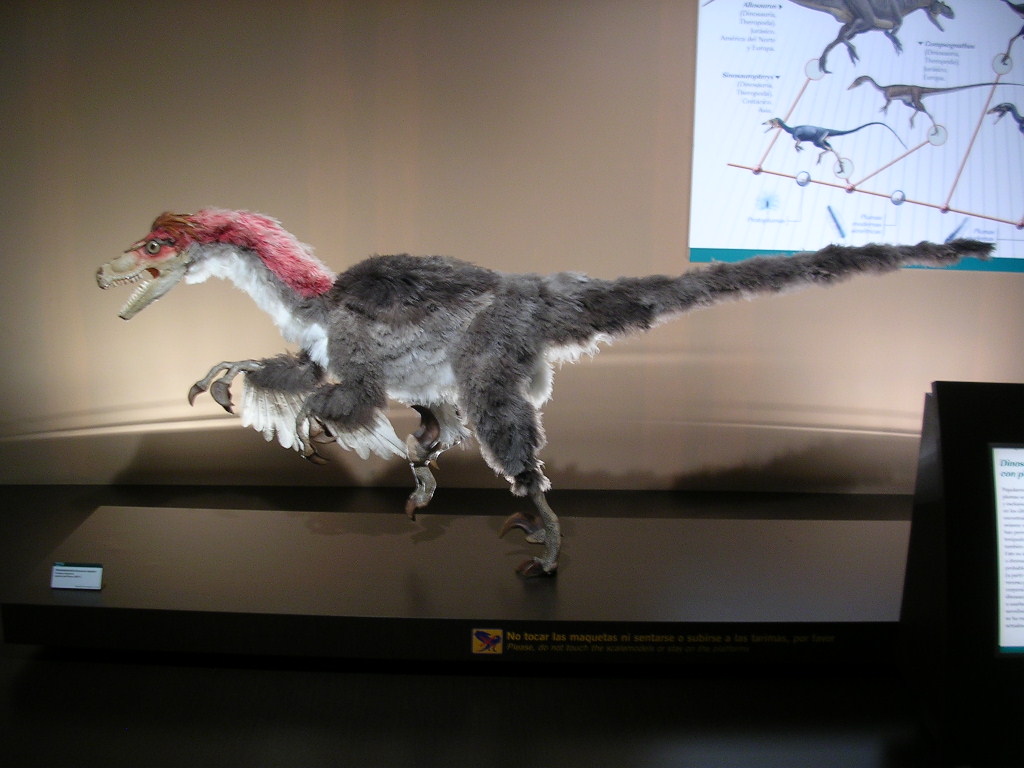 |
| No feathers seem to have been present on Velociraptor, but pcynofiber-like fuzz is still a possibility. |
What about “dinosaurs” that actually have fully-functional actual feathers?
Archaeopteryx and
Microraptor
are two such creatures. Both of these animals bear toothy snouts,
clawed and feathery wings and bony tails. They also both have a pair of
enlarged retractable toe claws like those of raptor dinosaurs, such as
Deinonychus and
Velociraptor. Surely this is proof that these animals are the missing links between dinosaurs and birds.
.jpg) |
| Microraptor is a very unique creature with four fully-functional feathered wings. |
First of all the feathers on the bodies of
Archaeopteryx and
Microraptor are
actual feathers and not collagen fibers or fur-like structures. They
also have the same digits configuration of modern birds (like modern
birds they bear the 2nd, 3rd and 4th digits). Undoubtedly, these animals
are birds. The fact that they have reptilian features does not make
them half reptile/half bird. In fact, there are several actual birds
that have reptilian features: ostriches and baby hoatzins also have
clawed wings, and no one questions that these animals are birds; the
extinct bird
Hesperornis possesses teeth in its beak; and the
seriema of today even has an enlarged second toe claw, similar to the
ones seen in raptors. If you don't need a missing link between dinosaurs
and birds (which creationists don't) then there's no need to call
Microraptor and
Archaeopteryx anything other than 100% birds.
.jpg/1920px-Seriamanail_(high_res).jpg) |
| The seriema is a medium-sized bird living today with an enlarged toe claw, similar to the ones found on dromaeosaurs. |
If you look in dinosaur books, you've likely seen diagrams similar to the one below:
 |
| This is a typical chart showing the evolution of dinosaurs to birds. |
This picture suggests that the fossil record
wonderfully displays the evolution from dinosaurs to birds; with more
dinosaur-like creatures in lower geologic rock layers and more bird-like
creatures in higher layers, slowly evolving more complex feathers.
Isn't it strange that we creationists reject the plain evidence in the
fossil record as Switek states we do?
Unfortunately,
this isn't what the fossil record represents at all! Despite this being
portrayed in just about every secular dinosaur book, the “clear fossil
record” (as Switek puts it) tells a different story.
Archaeopteryx,
the famed transitional between dinosaurs and birds is believed to have
existed 150-148 million years ago, during the Late Jurassic Period. The
problem? Most bird-like dinosaurs that are commonly said to be closely
related to birds, according to this worldview, lived
before Archaeopteryx!
Sinosauropteryx,
a dinosaur with “proto-feathers” is claimed to have lived 124-122
million years ago! In fact, most dinosaurs with so-called
“proto-feathers” are found above rock layers with more bird-like
animals! The only dinosaur with "proto-feathers" that evolutionists have
that didn't live after
Archaeopteryx is
Juravenator. But according to evolutionists,
Juravenator lived at the same time as
Archaeopteryx! In addition to this, we find birds very similar to the ones we see today living with "dino-birds". A
Microraptor skeleton described in 2011 was discovered with tree-perching bird fossils (more bird-like than
Microraptor) inside of its abdomen! This animal didn't only live with modern-like birds – it ate them! Even
Velociraptor,
a very bird-like dinosaur, is usually dated to live about 80 million
years ago, long after birds has supposedly been flying through the skies
for millions of years. These creatures were hardly ancestors to the
birds. I for think the fossil record clearly demonstrates that dinosaurs
evolved into birds, don't you? (That was sarcastic by the way).
Of course, I am not at all saying we should find
all
the transitional forms between dinosaurs and birds if this transition
really did occur, but we should find a few. Evolution on this scale
would take tens of millions of years and millions of generations between
dinosaurs and birds. Where are these fossils? Surely some should have
popped up if the "clear fossil record" suggests dinosaurs evolved into
birds.
And to make matters even worse for evolutionists, extinct birds such as
Anchiornis,
Xiaotingia,
Aurornis and potentially
Protoavis are buried in
sediment “older” than
Archaeopteryx!
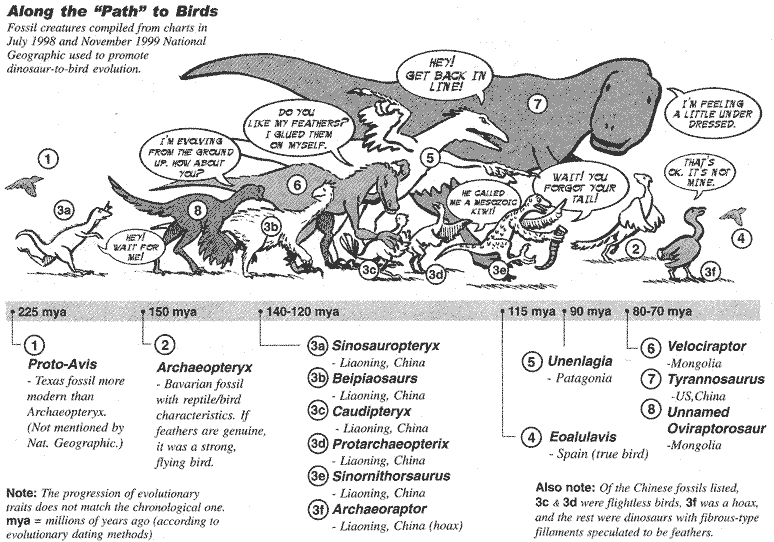 |
| So, Switek, you believe the "clear fossil record" portrays dinosaurs evolving into birds? Hm... |
|
|
Earlier, I mentioned how Switek claimed creationists
don't like feathered dinosaurs. What if a feathered dinosaur with actual
feathers were discovered? Would this prove that dinosaurs evolved into
birds and that the Bible is untrue? Nope! In fact, nothing in the Bible
goes
against the idea that dinosaurs might have had feathers. Not only that, but I happen to
like
the look of feathered dinosaurs; I am not against the notion of
feathered dinosaurs in the slightest, just the idea that they evolved
into birds. Finding a feathered dinosaur would be no different than
finding a mammal that lays eggs. which we actually have! The duck-billed
platypus and porcupine-like echidna are monotreme mammals that lay eggs
instead of giving birth to live young like all other mammals. Yet they
aren't half mammals/half reptiles; they're mammals that lay eggs. We
creationists aren't against the idea of feathered dinosaurs at all, it's
just that so far, the evidence for feathered dinosaurs is missing in
action.
 |
| Like Microraptor,
the platypus bears characteristics of many different creatures,
including the ability to lay eggs, a duck-like bill, a beaver-like tail
and webbed feet, a mammal's fur, the ability to use a form of sonar and
even a venomous spur. Yet it is not some evolutionary missing link, but a
mosaic. |
In order to prove that dinosaurs evolved into birds,
one would need to find evidence of a transition between the two in the
fossil record (like reptile scales evolving into feathers) and the
fossil record would need to show dinosaurs and birds evolving in the
right order. This is not what we find!
Why haven't
evolutionists who love to talk badly about creationists bring up the
points I made in this article? An even better question is why
would they
do such a thing? Never in Switek's article does he even mention these
problems with the dino-bird theory (or solutions to them)! Like many
other evolutionists out there, he decided to pick on the claim made by
creationists rather than
the evidence that backs up the claim in
order to make creationists sound like unprofessional idiots. What he
wrote in this article shows just how utterly and willingly ignorant he
is of creationism and what we believe to be true (and more importantly
why we believe it to be true).
As
I hope to have made clear throughout this article, if one looks at the
fossil record from an evolutionary perspective, we don't really learn
about the origin of birds. It's really sad how little research Switek
did on the truth about creationism,
Answers in Genesis,
dinosaurs, birds and the fossil record as a whole. I doubt hearing the
truth would have actually change his mind, but at least he would have
been more informed. Until he decides to learn what creationists actually
have to say and only talking about evidence from his own side of the
argument, he should avoid talking about creationism altogether. (Unlike
him, I used information from both sides).
I do however
hope that this article has enlightened you, my readers, and helped you
understand that the fossil record doesn't support the belief that birds
and dinosaurs didn't share the same lineage, but that they do share the
same wonderful Creator God.
 |
| You can relax, dinosaur lovers! The turkey you'll have for Thanksgiving this year isn't the descendant of this Velociraptor! |
References:
wikipedia.org/wiki/Origin_of_birds
answersingenesis.org/dinosaurs/feathers/did-dinosaurs-turn-into-birds
answersingenesis.org/dinosaurs/feathers/feathered-raptors-not-the-birds
wikipedia.org/wiki/Archaeopteryx
wikipedia.org/wiki/Microraptor
wikipedia.org/wiki/Sinosauropteryx
Feathered Dinosaurs Drive Creationists Crazy
Disclaimer:
Many (or in some cases all) of the photographs and images above are not
mine. If you own one or more of them and would like them to be removed,
politely let me know via one or both of the email addresses above.
Disclaimer
2: I know I've been talking negatively a lot about Brian Switek
article, but this isn't because I don't like the guy. I have read much
of his other material and admire his writing style; even though I don't
agree with everything he believes.

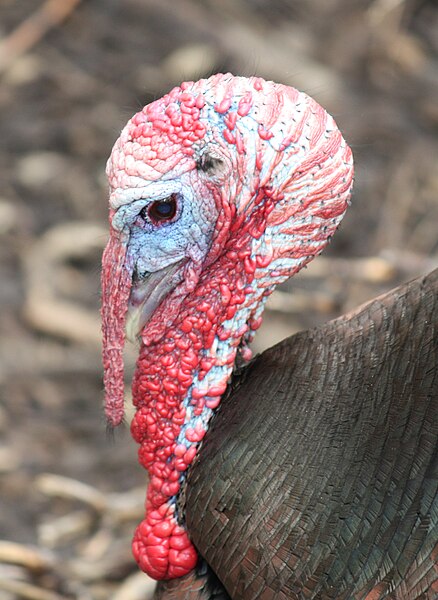
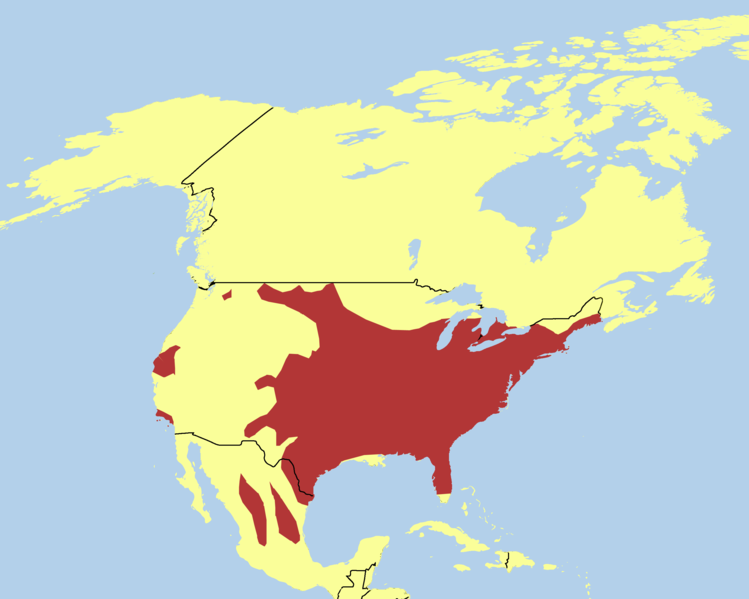


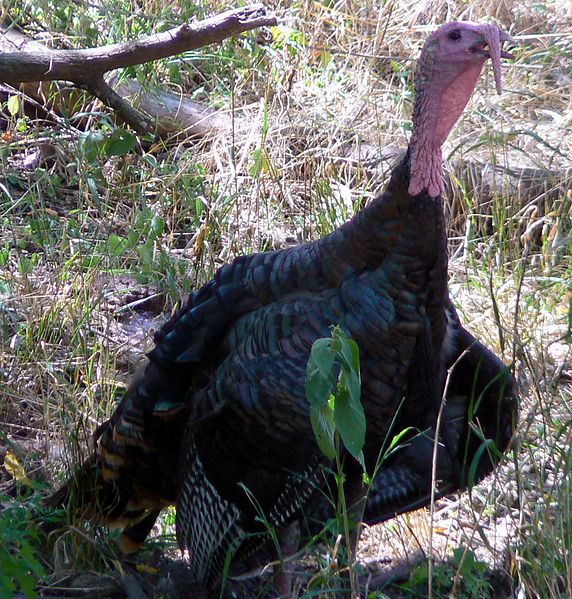

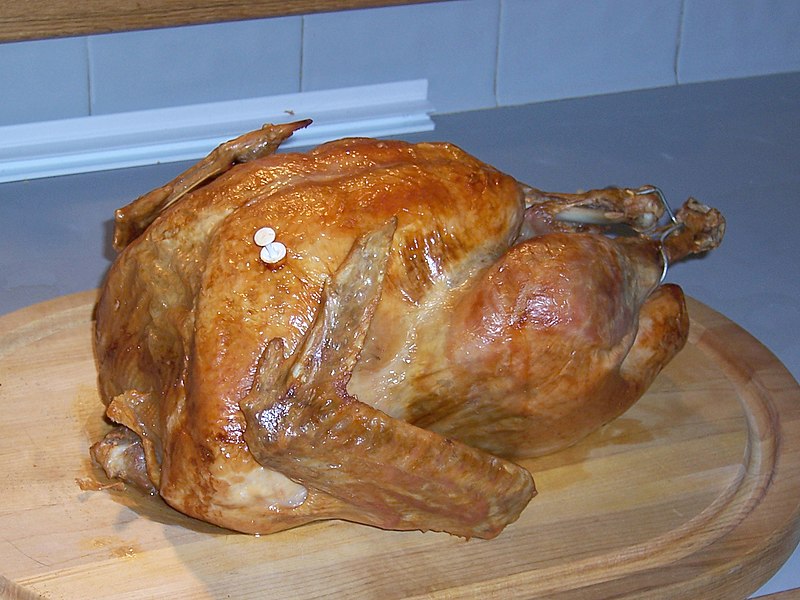




.jpg/640px-Archaeopteryx_lithographica_(Berlin_specimen).jpg)









.jpg)
.jpg/1920px-Seriamanail_(high_res).jpg)



